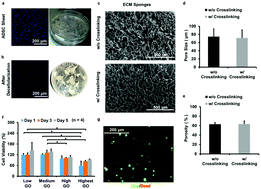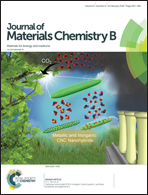Genipin-crosslinked adipose stem cell derived extracellular matrix-nano graphene oxide composite sponge for skin tissue engineering
Abstract
Autologous skin grafts, which can cause donor site morbidity, are currently used to treat deep wounds. To improve the regeneration of poorly healing wounds, cell-derived extracellular matrix (ECM) scaffolds are garnering great research interest due to their associated lower risks of pathogen transfer and immune rejection. However, the mechanical properties of cell-derived ECM scaffolds are inferior when compared to those of tissue-derived ECM scaffolds. To overcome this drawback, different amounts (10, 20, 50, and 100 μg mL−1) of graphene oxide (GO) and genipin (1% w/v) were applied to adipose stem cell (ASC)-derived ECM sponges. There are still only a few studies employing cell-derived extracellular matrices as biomimetic scaffolds for biomedical applications. The aim of our study was to develop biocompatible, biodegradable, low immunogenic, and genipin-crosslinked ASC-derived ECM sponges containing a suitable amount of GO for skin-tissue engineering. Sponges were fabricated using cultures of ASCs, cell sheets, and decellularization of an ASC cell sheet, freeze-thawing, and crosslinking in a sequential manner. Scanning electron microscopic analyses of the sponges demonstrated a highly porous microstructure with a pore size of 71.22 ± 19.52 μm. The in vitro degradation rate was found to be significantly higher in the non-crosslinked ECM sponges and pure ECM sponges than in the genipin-crosslinked ECM sponges. During an in vivo study, we investigated the material feasibilities and degradability of the constructed ECM sponges as a suitable skin tissue-engineering scaffold in a xenogenic animal (rat) model for 4 weeks. After subcutaneous implantation, the ECM sponges containing a medium amount of GO showed appropriate biodegradation with a lower inflammatory reaction. Hence, the fabricated ECM sponges might be a suitable xenogenous skin substitute for full-thickness skin defects and in other future soft-tissue engineering applications, such as healing partial tears of the anterior cruciate ligament.



 Please wait while we load your content...
Please wait while we load your content...